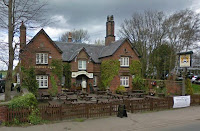I was recently rather surprised to see a comment about one of Brunning & Price’s pubs in the South-East describing their food as “hearty stuff at moderate prices”. Up here, I’d describe them as unashamedly expensive and up-market, and I doubt whether that is much different down there. Let’s take their nearest outlet to me, the Sutton Hall near Macclesfield. The menu, which obviously is likely to change, currently offers, for example:
* Braised shoulder of lamb with dauphinoise potatoes and redcurrant gravy £16.75Now, of course they are perfectly entitled to charge those prices, and I’m not saying the food isn’t worth it, but those dishes on a pub menu are unquestionably expensive, ambitious and upmarket. There are cheaper main courses, but nothing, not even ham, egg and chips, below £9.95. To be fair, their sandwiches are not so much out of line with other food-led pubs.
* Pan-fried seabass fillets with a chorizo, caper, lemon, herb and tomato dressing £15.25
To my mind, I would expect main dishes – excluding prime steaks and the like – in middle-of-the-road pubs to cost maybe between £7 and £9. Below £6 is cheap’n’cheerful, whereas over £9 is getting a bit steep, north of £10 and the eyes start to water.
The whole question of pricing in pubs, whether for food or drink, is far from simple. You have to consider the quality and choice of what is on offer, convenience of access, general atmosphere and the preferences of your companions. There may be forty pubs within easy reach of you, especially if you can travel directly to a town centre, but realistically on each occasion you’re unlikely to be choosing between more than a handful.
Recently, for beer of around 4.0%, I have paid £1.60 in a Sam Smith’s pub, £1.99 in Wetherspoon’s, £2.15 in a Holt’s, £2.46 in a Hydes’, £2.53 in a Lees’, £2.71 in a pub company outlet, £2.80 in a Robinson’s (one of the more upmarket ones), £3.30 in a Brunning & Price and £3.60 in the Pointing Dog in Cheadle Hulme, all within 15 miles of my house. This demonstrates the huge range of prices that are on offer. I won’t be going back to the Pointing Dog in a hurry, though. The Sam Smith’s beer was just as good as most, and rather better than some.
Each pub has its own target market, and the £3.30 in the smart B & P pub will be acceptable to those who have come for a meal and are only going to drink one or two pints, but won’t appeal to the local six pints a night men. But you do need to be careful that your pricing aspirations don’t go beyond what your customers think is reasonable, otherwise they will start to drift away. People still have a strong sense of fairness and value for money. Also, the headline prices of a pint of bitter and lager are likely to stick in the mind, and be readily comparable to other pubs, and so it makes sense not to be seen to be out of line on these.
And price competition is much more intense in town and city centres, where there is much more of a choice of pubs, and where the influence of Wetherspoon’s is likely to have been brought to bear.
It must be said too that people are often happy to condemn pubs they don’t like as expensive, while happily tolerating similar prices in those they do like.



































